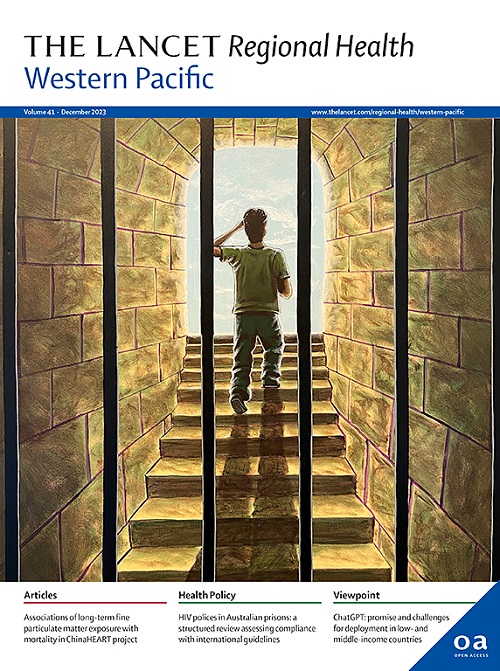上消化道肿瘤的机会性内镜筛查(open)项目的设计和评估:中国的一项现实世界研究
IF 8.1
1区 医学
Q1 HEALTH CARE SCIENCES & SERVICES
引用次数: 0
摘要
背景内镜筛查上消化道肿瘤在中国高危地区的有效性已经得到证实。然而,将这种筛查扩大到更广泛的地理区域的实用性仍不确定。为了弥补这一差距,我们自2018年以来开展了一项以医院为基础的UGI癌症机会性内窥镜筛查(open)计划。我们的目标是阐明开放式项目的实施过程,并评估其有效性。方法2019-2023年,共有710个区县875家医院参与了open项目。参与该项目的内窥镜专家和病理学家被要求参加年度培训计划,以获得基本的筛查技术。接受内窥镜检查的合格患者进行了UGI癌症筛查。诊断为高级别上皮内瘤变(HGIN)、原位癌(CIS)和食管或/和胃肿瘤的患者被定义为阳性病例。HGIN和CIS患者被定义为早期病例。所有医院都需要通过项目平台提交筛查数据,并对所提交数据的质量和医院绩效进行综合评估。参与医院所在地区/县的年龄标准化发病率(asir)来自2020年的癌症登记数据。UGI癌症asir超过22.0/105的地区/县被列为高危地区。计算阳性检出率(PDR)和早期诊断率(EDR)。数据清理后,我们纳入了来自616个区县的808家医院,2019-2023年期间共有7066892人参与。所有站点的总体PDR和EDR分别为2.35%和19.77%。食管pdr和edr分别为1.02%和23.18%,胃pdr分别为1.37%和17.80%。PDR在男性中高于女性(3.59% vs 1.20%),且随年龄增长而增加。女性的EDR高于男性(20.66%比19.45%),在60-64岁年龄组达到峰值。UGI癌高危区pdr和edr较高(p < 0.05)。在调整了年龄、性别、省份、筛查年份、地区UGI肿瘤发病率水平和医院级别后,连续5年参与该项目的医院的pdr和edr均高于其他医院(p < 0.05)。在连续参与的医院中,三级医院与二级医院相比,食道和胃的pdr均呈正相关(p < 0.001)。然而,三级医院与食道的EDR呈负相关(OR = 0.91, 95% CI: 0.86-0.96, p = 0.001),但与胃的EDR呈正相关(OR = 1.11, 95% CI: 1.05-1.17, p < 0.001)。“开放”项目在全国范围内迅速扩展。该项目显示出较高的pdr和edr,表现良好的医院显示出明显更好的筛查结果。在这些表现良好的医院中,二级医院在食管病变筛查方面的结果与三级医院相当,但在胃病变筛查方面则不然。考虑到中国目前的医院能力,培训指导的机会性UGI内镜筛查在不同UGI风险水平的地区显示出显著的可行性和有效性。中国科学院医学科学创新基金(项目编号:2021-I2M-1-061, 2021-I2M-1-023)。本文章由计算机程序翻译,如有差异,请以英文原文为准。
The design and evaluation of the opportunistic endoscopic screening (OpENS) program for upper gastrointestinal tract cancers: a real-world study in China
Background
The effectiveness of endoscopic screening for upper gastrointestinal (UGI) tract cancers in high-risk areas of China has been well-established. However, the practicality of extending this screening to a wider geographical area remains uncertain. To bridge this gap, we have conducted a hospital-based opportunistic endoscopic screening (OpENS) program for UGI cancers since 2018. Our objectives were to elucidate the implementation process of the OpENS program and assess its effectiveness.
Methods
875 hospitals from 710 districts/counties have participated in the OpENS program during 2019–2023. The endoscopic specialists and pathologists participating in the program were mandated to take annual training programs to acquire the fundamentals of screening techniques. Eligible patients who underwent endoscopic examinations were screened for UGI cancers. Patients diagnosed with high-grade intraepithelial neoplasia (HGIN), carcinoma in situ (CIS) and tumors in esophagus or/and stomach were defined as positive cases. Patients with HGIN and CIS were defined as early cases. All hospitals were required to submit screening data via the program's platform, with both the quality of the submitted data and the hospitals' performance being subject to a comprehensive evaluation. The age-standardized incidence rates (ASIRs) for the districts/counties where the participating hospitals were situated were derived from the cancer registry data for the year 2020. Districts/counties with ASIRs for UGI cancers over 22.0/105 were classified as high-risk areas. The positive detection rate (PDR) and early diagnosis rate (EDR) were calculated.
Findings
After data cleaning, we included 808 hospitals from 616 districts/counties, with a collective participation of 7,066,892 individuals during 2019–2023. The overall PDR and EDR across all sites were 2.35% and 19.77%. The PDRs and EDRs were 1.02% and 23.18% in esophagus, and were 1.37% and 17.80% in stomach. The PDR was higher among males compared to females (3.59% vs 1.20%), and was increasing with age. The EDR was higher among females compared to males (20.66% vs 19.45%), peaking in the age group of 60–64 years. The PDRs and EDRs were higher in high-risk areas of UGI cancers (p < 0.05). After adjusting for age, sex, province, year of screening, regional UGI cancer incidence level and hospital tier, the hospitals that consecutively participated in the program for five years demonstrated higher PDRs and EDRs when compared to other hospitals (p < 0.05). Among the consecutively participated hospitals, tertiary-level hospitals demonstrated positive associations with the PDRs for both the esophagus and stomach when compared to secondary-level hospitals (p < 0.001). However, the tertiary-level hospitals showed a negative association with the EDR for the esophagus (OR = 0.91, 95% CI: 0.86–0.96, p = 0.001), but exhibited a positive association with the EDR for the stomach (OR = 1.11, 95% CI: 1.05–1.17, p < 0.001).
Interpretation
The OpENS program has rapidly expanded across the country. The program has demonstrated high PDRs and EDRs, with hospitals that performed well exhibiting significantly better screening outcomes. Among these well-performed hospitals, secondary-level hospitals can achieve comparable results to tertiary-level hospitals in screening for esophageal lesions, albeit not for stomach lesions. Considering the current hospital capacities in China, the training-guided opportunistic UGI endoscopy screening exhibits significant feasibility and effectiveness across areas with varying level of UGI risks.
Funding
CAMS Innovation Fund for Medical Sciences (No. 2021-I2M-1-061, 2021-I2M-1-023).
求助全文
通过发布文献求助,成功后即可免费获取论文全文。
去求助
来源期刊

The Lancet Regional Health: Western Pacific
Medicine-Pediatrics, Perinatology and Child Health
CiteScore
8.80
自引率
2.80%
发文量
305
审稿时长
11 weeks
期刊介绍:
The Lancet Regional Health – Western Pacific, a gold open access journal, is an integral part of The Lancet's global initiative advocating for healthcare quality and access worldwide. It aims to advance clinical practice and health policy in the Western Pacific region, contributing to enhanced health outcomes. The journal publishes high-quality original research shedding light on clinical practice and health policy in the region. It also includes reviews, commentaries, and opinion pieces covering diverse regional health topics, such as infectious diseases, non-communicable diseases, child and adolescent health, maternal and reproductive health, aging health, mental health, the health workforce and systems, and health policy.
 求助内容:
求助内容: 应助结果提醒方式:
应助结果提醒方式:


